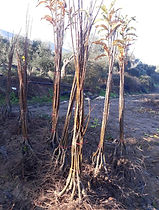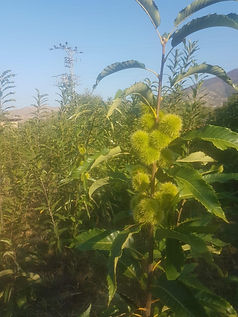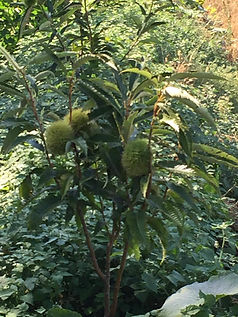
CHESTNUT SAPLING
Sale size of sapling
70 - 80 cm
- Age of the sapling
2.5 years old
Planting time
Since our fruit saplings are tubular, they can be planted every month of the year.
- Chestnut sapling's light request
Generally all fruits love the sun. You can also plant it where it gets half sun.
- Sapling amount in sale
Fruit saplings are never planted alone. You always plant the fruit seedlings in pairs, because by fertilizing each other, the fruit drop will be double.
- The lowest temperature it can withstand
Minus 15 degrees
- Defoliation feature
It sheds in the winter.
- Where to plant the chestnut sapling
Sapling production in our country has been produced semi-dwarf for the last 10 years. For this, you can plant your fruit sapling in the garden, on the balcony or in your workplace.
- Formful growth
3 meters to 5 meters
- Sapling's irrigation request
In the winter months, you do not need to water it because of the rain. In the summer, you need to water as the bottom of the fruit tree dries.
Pruning time and shape
The branches of the tree that come up like arrows will be cut. When looking from the top, the middle branches will be pruned so that the main body is visible in the middle.
- Fertilization time of chestnut seedlings
Fertilization will be made to the tree once a year. Drill 3 - 4 holes in the projection that corresponds to the tip branches, not just the bottom, throw 15 + 15 + 15 type fertilizers between a teaspoon and a tablespoon according to the age of the tree and close the hole with soil.
- Spraying time
If there is no sign of disease in the area where it is planted, it does not want spraying. If you do not want to cause an event such as leaf disease and insect infestation on the tree, mix fungicide and insecticide type drugs and spray the sapling several times with 15 days intervals.
- Sapling growth rate
This speed is directly proportional to the good feeding and care of the owner. The growth rate changes due to the difference in altitude.
- Production status
The rootstocks grown with tissue culture, namely the saplings called mad harap, were produced by eye and pen grafting method.
- How many years does a chestnut sapling live?
There are those who live for 50 years around us.
- In what container is sewn on sale
It is offered for sale as tubed and grafted in flower pots or bags.
- How many kg of soil are under
1 to 2 kg.
-Planting knowledge of sapling
The bigger the hole you dig where it will be planted, you will win. Since the roots of the plant move very quickly in the soft soil, the body grows so quickly. Sew the vaccine without covering it and make a pool around it. Give life water.
- Chestnut sapling planting interval
It can be 4.5 to 6 meters depending on the size of your place.
- Flowering period
Spring months
- Fruit harvest time
Autumn months
- The way of packing
In order not to damage the cargo, we use hard packaging materials, wrap it well with duct tape and send it to you.
- Things to do when the sapling comes to you
First take it out of the package and water it. Leave it in the shade until it will be planted. Do not fertilize before two months after planting. Fertilizer is not applied to a plant whose root development has not been completed.
- Footnote
Chestnut saplings are one of the fruits that are so enjoyable to eat in the winter months, which reach huge sizes. Our chestnut saplings are produced from high quality rootstocks and grafted.





KESTANE ÇEŞİTLERİMİZ
MARİGOULE KESTANE
Thin crust, fertile, coarse
It is based on cold.
Doesn't like a lot of rain.
It is reproduced by vaccine.
The shell of the yellow cheesecake chestnut variety is thin.
Yellow ashlar chestnut is very productive.
Anatolia is the homeland of Castanea Sativa (European chestnuts), to which the best quality chestnut varieties in the world belong.
In order for the chestnuts to ripen their fruits, the total daily temperature from flowering to harvest day should be 2000 -2300 hours.
Chestnut can withstand winter low temperatures up to -30 degrees.
However, Spring and Autumn are sensitive to the first frosts.
Chestnuts are affected by drought rather than high temperatures in summer. Winter cooling needs are medium.
Chestnuts can be grown without irrigation in places with a total annual rainfall of 600-1600 mm and a regular seasonal distribution. Therefore, regular precipitation is important for chestnuts.
Excessive rainfall during flowering period negatively affects fruit set. In addition, in such seasons, Septoria Castanicola fungus develops and causes the leaves to fall off.
Chestnut is a pile rooted plant.
The soil of the place where the garden is planned to be established should be loose and deep.
Soils rich in potassium should be preferred.
Soil PH level is desired to be around 5-6.3.
It does not develop well in heavy clayey soils with low water permeability.
Although the methods of propagation dipping and rooting with cuttings are used in chestnuts, the most common method is grafting.
The soil should be permeable, deep and ventilated. It is not suitable for chestnut cultivation in ground lands with heavy clayey ground water.
Hollow valleys where cold is gathered pose a danger for chestnut cultivation. Gardens should be established at least 400 m above sea level.
Maraval
Maraval is a European Japanese hybrid of French origin.
Its resistance to branch cancer is very good.
Yield is normal.
Suitable for 400-900 altitude.
Harvest date is the second week of October.
Fruit grains are very large.
Yerli Kestaneler
Vakit chestnut: It is grown in the coastal region of Yalova. Fruits are triangular. The skin is of medium thickness, the color is bright with a chestnut color, the fruit tip is prominently hairy, the surface is slightly striped. Inside is cream-colored, the seed membrane penetrates into the seed and is difficult to peel when fresh. It is a very productive variety and bears fruit every year. It is harvested in the last week of September. It blooms in the middle season.
İnegöl: Its fruits are nearly round oval. The skin is thin, typical chestnut color, shiny, surface lines are less noticeable. The inside is cream-colored, the seed membrane penetrates the seed and is easy to peel when fresh. This type, which is productive and yields every year, is harvested in the last week of September. Fruit size varies greatly over the years.
Early varieties:
These varieties are generally in the very small fruited group. They are very early.
Karamehmet : Fruits are close to round, the fruit skin is darker, less bright and thick. Inside is cream-colored, the seed membrane is little or no penetration into the seed and it is difficult to peel when fresh. These varieties with moderate yields yield every year. It is harvested in the first week of September. Fruits are very small.
Hacıibiş: Fruits are close to round, the fruit skin is close to the middle, less bright and thick. The inside is cream-colored, the seed membrane is little or does not penetrate the seed. When fresh it is usually difficult to peel. This variety, which is very productive, tends to yield every year. It is harvested in the second week of September. Fruits are very small.
Osmanoğlu: He is an early man. Fruits are generally oval-shaped and sometimes triangular, symmetry in fruits is not always complete. The skin is thin, typical chestnut color, bright slightly hairy (fruit tip is more hairy), the surface is slightly striped with gaps. Inside is cream-colored, the seed membrane penetrates into the seed and is difficult to peel when fresh. However, it is used in confectionery due to the less dispersion of its seeds while boiling. This variety, which is productive and yields every year, is harvested in the second week of September. Fruit size varies greatly over the years.



